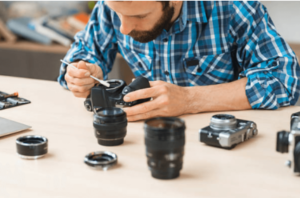A GUIDE FOR PHOTOGRAPHERS
Welcome to the realm of photography, where our mission is to capture fleeting moments and create stunning images. Keeping up with the latest advancements in camera technology is vital for honing your skills and achieving outstanding results, no matter your level of expertise. Staying informed about the ever-evolving trends and innovations in the industry can be challenging, but fear not! This comprehensive guide will assist you in navigating the intricate world of camera technology, from mastering the fundamentals to preparing for future advancements.
We will look at many camera kinds, go into the details of camera megapixels and sensors, and talk about different image stabilization methods in this tutorial. We will also go into selecting the best camera for your individual requirements, taking into account things like your budget, genre preferences, and photographic aspirations. You can have a better understanding of the significance of lens options, manual settings, modes, and auto-focus systems by investigating camera features and specifications.
It’s also critical to keep up with industry trends, and we’ll talk about how to accomplish so by visiting photography exhibitions, reading blogs and websites, and getting advice from professionals in the field. We will also discuss the importance of post-processing and look at color calibration, digital asset management, and editing tools.
However, our adventure doesn’t stop there. Next, we’ll discuss projecting camera technology into the future, making investments in equipment that will last, and stressing the value of lifelong learning and adaptation.
Comprehending Camera Technology
Greetings and welcome to the second part of our guide on keeping up with the newest developments in camera technology! We will go deeply into the world of cameras in this section and examine the various facets of camera technology that are essential knowledge for any photographer. Now let’s get going!
Camera Types
Point-and-shoot cameras, sometimes referred to as compact cameras, are tiny, lightweight equipment that are ideal for sporadic photography. They are easy for beginners to use because they include automatic settings and built-in lenses.
DSLR Photographers: Professional photographers utilize Digital Single-Lens Reflex (DSLR) cameras in large numbers. They include manual setting control, bigger sensors, and lens interchangeability. These cameras offer outstanding adaptability and image quality.
Cameras without mirrors: Mirrorless cameras are growing in popularity because of their sophisticated features and small size. Unlike DSLRs, they don’t have a mirror system, which makes their bodies lighter and smaller. Mirrorless cameras have great autofocus performance and electronic viewfinders.
Megapixels and Camera Sensors
Any digital camera’s heart is its camera sensor. The image is created by converting light into an electrical signal. There are two primary categories of camera sensors:
Full-Screen Sensors: These sensors provide better image quality, especially in low light, yet are comparable in size to conventional 35mm film. Full-frame cameras are more expensive and are typically utilized by professional photographers.
APS-C Sensors: Despite being smaller than full-frame sensors, APS-C sensors produce outstanding image quality. APS-C sensor cameras are more reasonably priced and appropriate for a variety of shooting disciplines.
Let’s now discuss megapixels. The resolution of an image taken by a camera is measured in megapixels. It’s crucial to remember that megapixels are not the only measure of image quality, even if having more megapixels might provide photos with greater detail. Other important factors are lens quality, picture processing, and sensor size.
Techniques for Image Stabilization
When using a telephoto lens or in low light, picture stabilization is extremely important for getting clear, blur-free photos. Two popular methods for stabilizing images are as follows:
In-Body Image Stabilization (IBIS): This technology is built into the body of the camera and uses movement of the sensor to counteract shake in order to compensate for camera shake. Any lens that is fastened to the camera can be stabilized thanks to IBIS.
Lens-based Image Stabilization: A few camera lenses have image stabilization mechanisms integrated into them. To compensate for camera motion, these lenses contain motors that move particular lens components. Lens-specific image stabilization varies depending on the model of lens used.
It’s crucial to comprehend camera technology in order to get the best camera for your purposes and produce breathtaking photos. We will look at how to select the ideal camera based on your preferences and photographic aspirations in the following part. Keep checking back!
RELATED POSTS

Understanding Different File Types and Their Impact on Memory Card Storage

How Can You Fix Focus Issues in a Camera Lens That Consistently Produces Soft or Blurry Images?

How Photographers Can Optimize Their Use of Multifunctional Control Dials for Faster Adjustments ?

